Themed collection 2023 Journal of Materials Chemistry Lectureship runners-up: Kwabena Bediako and Laure Biniek

Recent advances in high mobility donor–acceptor semiconducting polymers
In this Highlight, we present the most recent work on solution processable high mobility donor–acceptor type polymers. We discuss the approaches that have been taken to improve both hole (and electron) mobility further. We will not only focus on chemical design criteria, but also describe certain processing approaches which have led to impressive hole mobilities of up to 5.5 cm2/Vs.

J. Mater. Chem., 2012,22, 14803-14813
https://doi.org/10.1039/C2JM31943H
Multi length scale porosity as a playground for organic thermoelectric applications
Porous conducting polymers are intriguing heat harvester candidates. This review focuses on the different strategies to vary the porosity range (from micro- to macro-pores) and their impact on thermoelectric properties.
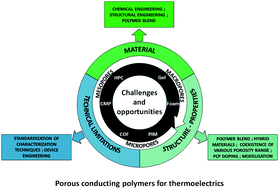
J. Mater. Chem. C, 2021,9, 10173-10192
https://doi.org/10.1039/D1TC02331D
Proton -coupled electron transfer kinetics for the hydrogen evolution reaction of hangman porphyrins
Kinetics studies with both hangman and non-hangman systems reveal the precise PCET pathway involved in the formation of a key CoIIH intermediate.

Energy Environ. Sci., 2012,5, 7737-7740
https://doi.org/10.1039/C2EE21123H
Tailoring the 3D porous structure of conducting PEDOT:PSS gels via ice-templating
Well-controlled gelation of fibrillar PEDOT:PSS and growth of ice crystals yield robust anisotropic macroporous materials with a tuned pore size. The honey-comb like structure is at the origin of the low thermal conductivity.

J. Mater. Chem. C, 2023,11, 7802-7816
https://doi.org/10.1039/D3TC01110K
High thermal conductivity states and enhanced figure of merit in aligned polymer thermoelectric materials
Control of morphology and chain alignment in polymer thermoelectric materials is critical to their performance. A x25 improvement in zT is reported for chain aligned films.
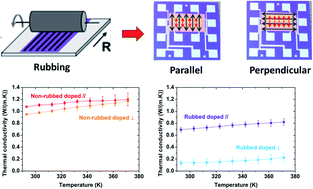
J. Mater. Chem. A, 2021,9, 16065-16075
https://doi.org/10.1039/D1TA03377H
Original polymorphism in a naphthalene bisimide π-conjugated organogelator: a complex interplay between hydrogen bonding and heterocycle π-stacking
A naphthalene bisimide organogelator forms different supramolecular assemblies in the gel phase and in the solid states; the structures of these different polymorphs have been uncovered by electron and X-ray diffraction, UV and FTIR spectroscopies.
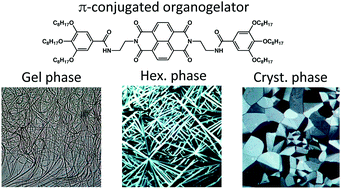
J. Mater. Chem. C, 2019,7, 13120-13129
https://doi.org/10.1039/C9TC04402G
Tuning crystallochromism in diketopyrrolopyrrole-co-thieno[3,2-b]thiophene derivatives by the architecture of their alkyl side chains
The first evidence of sensitivity to light polarization in TTDPP crystals.
![Graphical abstract: Tuning crystallochromism in diketopyrrolopyrrole-co-thieno[3,2-b]thiophene derivatives by the architecture of their alkyl side chains](/en/Image/Get?imageInfo.ImageType=GA&imageInfo.ImageIdentifier.ManuscriptID=C8TC02022A&imageInfo.ImageIdentifier.Year=2018)
J. Mater. Chem. C, 2018,6, 9140-9151
https://doi.org/10.1039/C8TC02022A
Supramolecular organization of a H-bonded perylene bisimide organogelator determined by transmission electron microscopy, grazing incidence X-ray diffraction and polarized infra-red spectroscopy
Polarized FTIR and TEM helps determine the supramolecular organization of PBI gelators.
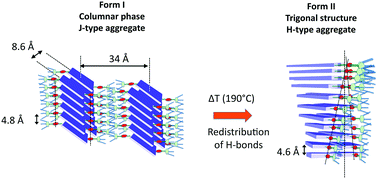
Phys. Chem. Chem. Phys., 2017,19, 32514-32525
https://doi.org/10.1039/C7CP06761E
Tailoring the microstructure and charge transport in conjugated polymers by alkyl side-chain engineering
Transport measurements with in-situ XRD reveal low alkyl side-chain densities to induce an ordered helicoidal conformation with large electronic energy disorder.
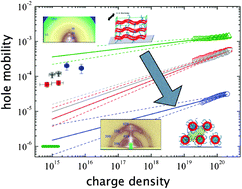
J. Mater. Chem. C, 2016,4, 286-294
https://doi.org/10.1039/C5TC03000E
Zipper-like molecular packing of donor–acceptor conjugated co-oligomers based on perylenediimide
The structure of perylene diimide co-oligomers used in organic photovoltaics is uncovered by TEM and GIXD on highly oriented films.

J. Mater. Chem. C, 2015,3, 3342-3349
https://doi.org/10.1039/C5TC00221D
Reversible J- to H-aggregate transformation in thin films of a perylenebisimide organogelator
A perylene bisimide organogelator is shown to behave as a reversible stimuli responsive material: thermal annealing and contact with organic non solvents allow to switch back and forth between a green J-type (Form I) and a red H-type (Form II) aggregate in thin films and powders of a N,N′-substituted H-bonding perylenebisimide (PBI-C10).

J. Mater. Chem. C, 2015,3, 1235-1242
https://doi.org/10.1039/C4TC02444C
Synthesis of [1]benzothieno[3,2-b][1]benzothiophene pendant and norbornene random co-polymers via ring opening metathesis
2-Octyl-7-(11-(cis-5-norbornene-endo-2,3-dicarboxylicimide)undecane)[1]benzothienopheno[3,2-b] benzothienophene (1) was synthesised and co-polymerised with 1-decyl(cis-5-norbornene-endo-2,3-dicarboxylic) imide (2) or norbornene, using a ruthenium catalyst.
![Graphical abstract: Synthesis of [1]benzothieno[3,2-b][1]benzothiophene pendant and norbornene random co-polymers via ring opening metathesis](/en/Image/Get?imageInfo.ImageType=GA&imageInfo.ImageIdentifier.ManuscriptID=C3TC32058H&imageInfo.ImageIdentifier.Year=2014)
J. Mater. Chem. C, 2014,2, 538-541
https://doi.org/10.1039/C3TC32058H
About this collection
The Journal of Materials Chemistry annual lectureship, established in 2010, honours early-career scientists who have made a significant contribution to the field of materials chemistry.
Dr Jovana Milić (University of Fribourg, Switzerland) is the recipient of the 2023 Journal of Materials Chemistry Lectureship. We have also recognised two outstanding runners-up, Dr Kwabena Bediako (University of California, Berkeley, USA) and Dr Laure Biniek (Institut Charles Sadron, CNRS – Strasbourg, France).
Each year we have a large number of excellent researchers nominated for the lectureship award across Journal of Materials Chemistry A, B and C. To recognise the diversity of the three journals, overall community and candidates nominated each year, we have decided to additionally recognise runners-up for the Journal of Materials Chemistry Lectureship.
To celebrate, we have collated some of Kwabena and Laure’s publications in Royal Society of Chemistry journals in this 2023 Lectureship runners-up web collection.
Why not also check out our collection celebrating the
2023 Journal of Materials Chemistry winner: Jovana Milić